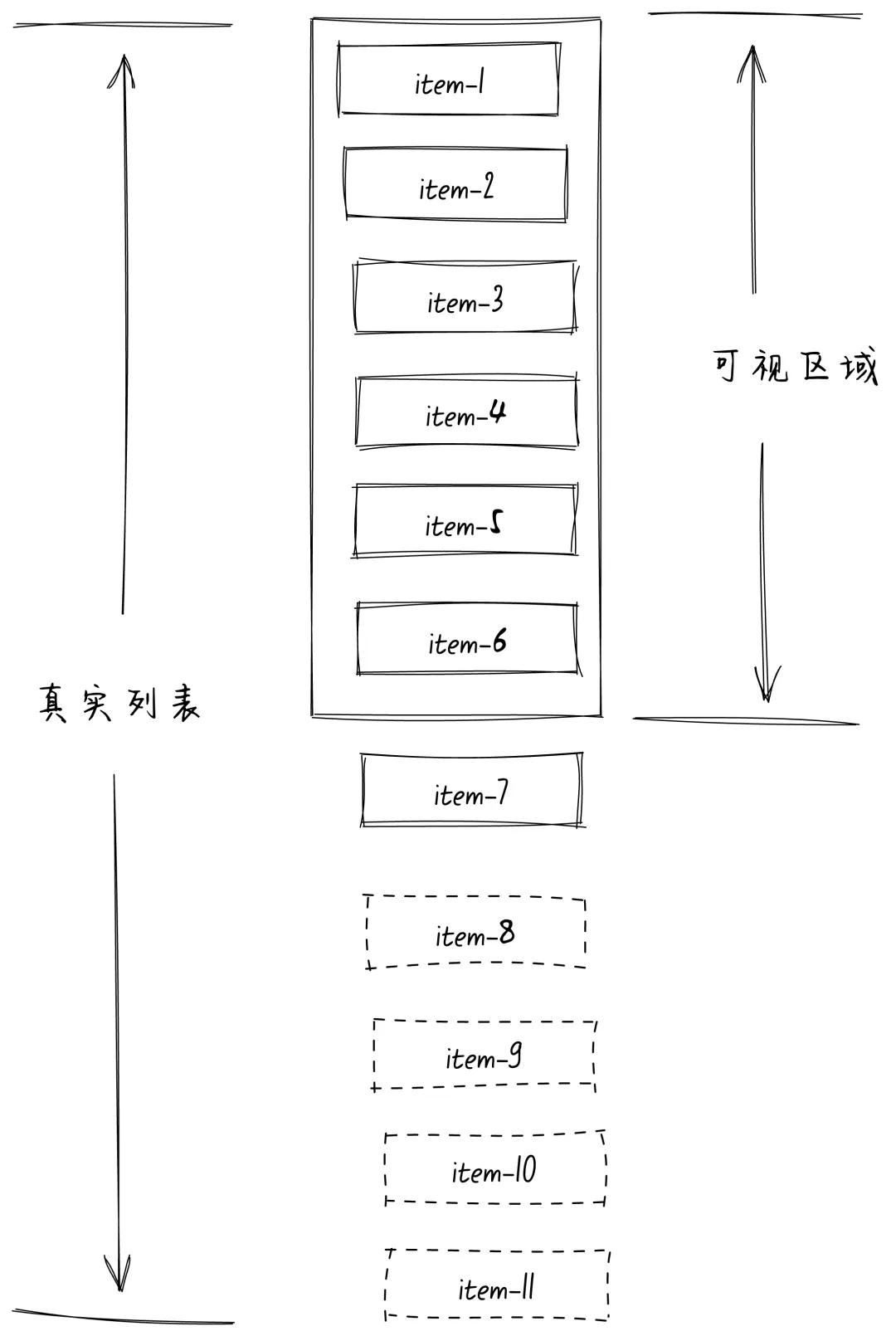虚拟列表
虚拟列表-完美的障眼法
前言
虚拟列表在C端和B端大量数据展示,有些切图仔一点不陌生,有些就很陌生感觉很高端的样子呢🧐
什么是虚拟列表
有的特殊场景我们不能分页,只能渲染一个长列表。这个长列表中可能有几万条数据,如果全部渲染到页面上用户的设备差点可能就会直接卡死了,这时我们就需要虚拟列表来解决问题

其中实线框的item表示在视口区域内真实渲染DOM,虚线框的item表示并没有渲染的DOM。
在item固定的的虚拟列表中,我们可以根据可视区域的高度和每个item的高度计算得出在可视区域内可以渲染多少个item。不在可视区域里面的item那么就不需要渲染了(不管有几万个还是几十万个item),这样就能解决长列表性能很差的问题啦。
实现原理
我们需要知道item 的高度 从而计算出 可视区应该展示多少个 item,通过滚动条拖动来动态计算 可视区展示的items
滚动条如何产生?
滚动容器内放置一个div原素 高度 = 总数据的长度 * item的高度即可
实现滚动条
根据上图dom结构应该是这样子
<template>
<div class='app-virtual-list'>
<ol class='app-virtual-container' style={this.containerStyle}>
<!-- 只渲染可视区域列表数据 -->
</ol>
</div>
</template>
<style>
.app-virtual-list {
position: relative;
height: 100%;
padding: 10px 0;
overflow-y: auto;
}
.app-virtual-container {
position: absolute;
inset: 0;
height: 100%;
padding: 0;
margin: 0;
overflow: hidden;
list-style: none;
}
.app-virtual-scroll-bar {
position: absolute;
top: 0;
right: 0;
z-index: -1;
width: 1px;
visibility: hidden;
}
</style>
滚动条怎么来?
非常简单,我们知道每个item的高度itemHeight,并且知道有多少条数据data.length。那么itemHeight * data.length不就是真实的列表高度了吗
<div class='app-virtual-list'>
<div class='app-virtual-scroll-bar' style={{ height: this.listHeight + 'px' }} />
<ol class='app-virtual-container' style={this.containerStyle}>
<!-- 只渲染可视区域列表数据 -->
</ol>
</div>
.app-virtual-scroll-bar 采用绝对定位,为了不遮挡住内容,所以需要设置z-index: -1
可视区展示多少个item?
实际上非常简单
可视区可展示数量 = 向上取整(可视区高度 / item 高度)
/**
* 可视区高度
*/
const screenHeight = ref(0)
/**
* 可视区可展示数量 = 向上取整(可视区高度 / item 高度)
*/
const visibleCount = computed(function () {
return Math.ceil(screenHeight.value / props.itemHeight)
})
onMounted(function () {
screenHeight.value = virtualContainer.value.clientHeight
})
可视区高度 = app-virtual-list容器的高度
为什么要使用Math.ceil向上取整呢?
因为如果少了一个在滚动时只要有个item在可视区域漏了一点出来,我们也应该将其渲染
此时我们得到一下几个变量
- 可视区可展示数量 = 向上取整(可视区高度 / item 高度)
- 数据的结束索引 = 起始索引 + 可视区可展示数量
- 数据起始索引 = 向下取整(滚动高度 / item 高度)
- 真实渲染items = 总数据列表.slice(数据起始索引, 数据结束索引)
- 列表总高度 = item高度 * 总数据列表长度
/**
* 可视区高度
*/
const screenHeight = ref(0)
/**
* @type {import('vue').Ref<HTMLUListElement>}
*/
const virtualContainer = ref()
/**
* 可视区可展示数量 = 向上取整(可视区高度 / item 高度)
*/
const visibleCount = computed(function () {
return Math.ceil(screenHeight.value / props.itemHeight)
})
/**
* 滚动的高度
*/
const scrollTop = ref(0)
/**
* 列表总高度 = item 高度 * 总数量
*/
const listHeight = computed(function () {
return props.data.length * props.itemHeight
})
/**
* 数据的起始索引 = 向下取整(滚动高度 / item 高度)
*/
const startIndex = computed(function () {
return Math.floor(scrollTop.value / props.itemHeight)
})
/**
* 数据的结束索引 = 起始索引 + 可视区可展示数量
*/
const endIndex = computed(function () {
return startIndex.value + visibleCount.value
})
const offset = ref(0)
/**
* 列表显示数据为
*/
const visibleData = computed(function () {
return props.data.slice(startIndex.value, Math.min(endIndex.value, props.data.length))
})
/**
* @type {import('vue').Ref<import('vue/types/jsx').StyleValue>}
*/
const containerStyle = computed(function () {
return {
transform: `translate3d(0, ${offset.value}px, 0)`
}
})
onMounted(function () {
screenHeight.value = virtualContainer.value.clientHeight
})
为何起始索引是由 向下取整(滚动高度 / item 高度)?
例如item高度 = 50 滚动高度是100 那么就代表2个item已被遮住
向下取整是因为如何如果当滚动高度是80时,则代表第二个item有一部分被遮住一部分还在可视区,则不能判定已经遮住
滚动事件
/**
* @param {UIEvent} e
*/
function onScroll(e) {
/**
* @type {HTMLUListElement}
*/
const target = e.target
scrollTop.value = target.scrollTop
offset.value = target.scrollTop - (target.scrollTop % props.itemHeight)
}
offset 是如何得来?
首先我们要明白,我们手动创建了真实item的高度app-virtual-scroll-bar那我们滚动的时候拖动的是真实的滚动条,可视区的高度始终是固定的。那么我们在滚动容器的时候,则内容需要跟随滚动条位置,否则容器内items则被卷进去,所以需要给items容器设置一个偏移量让他始终保持在可视区位置
如何计算 offset?
正常来讲scrollTop的值就是offset的偏移量,但是因为当item高度 = 50 滚动高度是120,此时第二个未被遮住那么他距离容器的顶部距离则是20scrollTop % itemHeight(如果非0则表示被除数无法被整除)所以offset的真实值是 scrollTop -(scrollTop % itemHeight)
扩展一下
我们给新增个功能,滚动到底部一定位置触发事件,让父组件去获取数据,从而实现无限滚动加载数据
Props
| Name | Type | describe |
|---|---|---|
limit | Number | 分页大小 |
current | Number | 当前第几页 |
rowKey | String | key |
offset | Number | 底部偏移量 |
默认Props配置
const defaultProp = { limit: 15, current: 1, rowKey: 'id', offset: 80 }
需要改动的地方很小
我们需要新增一个loading变量,在滚动的时候,判断
如果处于loading时则 return
否则计算最底部item 距离 可视区的距离 是否 >= options.offset 触发 end 事件 通知父组件获取数据
/**
* @param {UIEvent} e
*/
function onScroll(e) {
/**
* @type {HTMLUListElement}
*/
const target = e.target
scrollTop.value = target.scrollTop
startOffset.value = target.scrollTop - (target.scrollTop % props.itemHeight)
if (loading.value) return
if (target.scrollHeight - target.scrollTop - screenHeight.value < options.offset) {
loading.value = true
options.current += 1
context.emit('end', options)
}
}
通过向外暴露loaded方法来通知虚拟列表,数据加载完毕
首次使用时,自动触发 end 事件,让父组件开始获取数据
function loaded() {
loading.value = false
}
context.emit('end', options)
loading.value = true
context.expose({ loaded })
完整的代码
组件
import { computed, defineComponent, onMounted, ref } from 'vue'
import './style.scss'
const defaultProp = { limit: 15, current: 1, rowKey: 'id', offset: 80 }
export default defineComponent({
name: 'app-virtual-list',
props: {
data: {
type: Array,
default: () => []
},
/** item 高度 */
itemHeight: {
type: Number,
required: true
},
prop: {
type: Object,
default: () => defaultProp
}
},
setup(props, context) {
/**
* @type {{limit: number, current: number, rowKey: string, offset: number}}
*/
const options = Object.assign({}, defaultProp, props.prop)
const loading = ref(false)
/**
* 可视区高度
*/
const screenHeight = ref(0)
/**
* @type {import('vue').Ref<HTMLUListElement>}
*/
const virtualContainer = ref()
/**
* 可视区可展示数量 = 向上取整(可视区高度 / item 高度)
*/
const visibleCount = computed(function () {
return Math.ceil(screenHeight.value / props.itemHeight)
})
/**
* 滚动的高度
*/
const scrollTop = ref(0)
/**
* 列表总高度 = item 高度 * 总数量
*/
const listHeight = computed(function () {
return props.data.length * props.itemHeight
})
/**
* 数据的起始索引 = 向下取整(滚动高度 / item 高度)
*/
const startIndex = computed(function () {
return Math.floor(scrollTop.value / props.itemHeight)
})
/**
* 数据的结束索引 = 起始索引 + 可视区可展示数量
*/
const endIndex = computed(function () {
return startIndex.value + visibleCount.value
})
const startOffset = ref(0)
/**
* 列表显示数据为
*/
const visibleData = computed(function () {
return props.data.slice(startIndex.value, Math.min(endIndex.value, props.data.length))
})
/**
* @type {import('vue').Ref<import('vue/types/jsx').StyleValue>}
*/
const containerStyle = computed(function () {
return {
transform: `translate3d(0, ${startOffset.value}px, 0)`
}
})
onMounted(function () {
screenHeight.value = virtualContainer.value.clientHeight
})
/**
* @param {UIEvent} e
*/
function onScroll(e) {
/**
* @type {HTMLUListElement}
*/
const target = e.target
scrollTop.value = target.scrollTop
startOffset.value = target.scrollTop - (target.scrollTop % props.itemHeight)
if (loading.value) return
if (target.scrollHeight - target.scrollTop - screenHeight.value < options.offset) {
loading.value = true
options.current += 1
context.emit('end', options)
}
}
function loaded() {
loading.value = false
}
context.emit('end', options)
loading.value = true
context.expose({ loaded })
return {
options,
virtualContainer,
listHeight,
containerStyle,
visibleData,
onScroll
}
},
render() {
return (
<div class='app-virtual-list' ref='virtualContainer' onScroll={this.onScroll}>
<div class='app-virtual-scroll-bar' style={{ height: this.listHeight + 'px' }} />
<ol class='app-virtual-container' style={this.containerStyle}>
{this.visibleData.map(item => (
<li
class='app-virtual-item'
key={item[this.options.rowKey]}
style={{ height: this.itemHeight + 'px' }}
>
{this.$scopedSlots.default(item)}
</li>
))}
</ol>
</div>
)
}
})
样式
.app-virtual-list {
position: relative;
height: 100%;
padding: 10px 0;
overflow-y: auto;
}
.app-virtual-container {
position: absolute;
inset: 0;
height: 100%;
padding: 0;
margin: 0;
overflow: hidden;
list-style: none;
}
.app-virtual-scroll-bar {
position: absolute;
top: 0;
right: 0;
z-index: -1;
width: 1px;
visibility: hidden;
}
最后
虚拟列表的原理我也看过不少文章,也是似懂半懂的样子,所以想写个组件彻底了解原理可以温故知新
祝大家新春快乐
